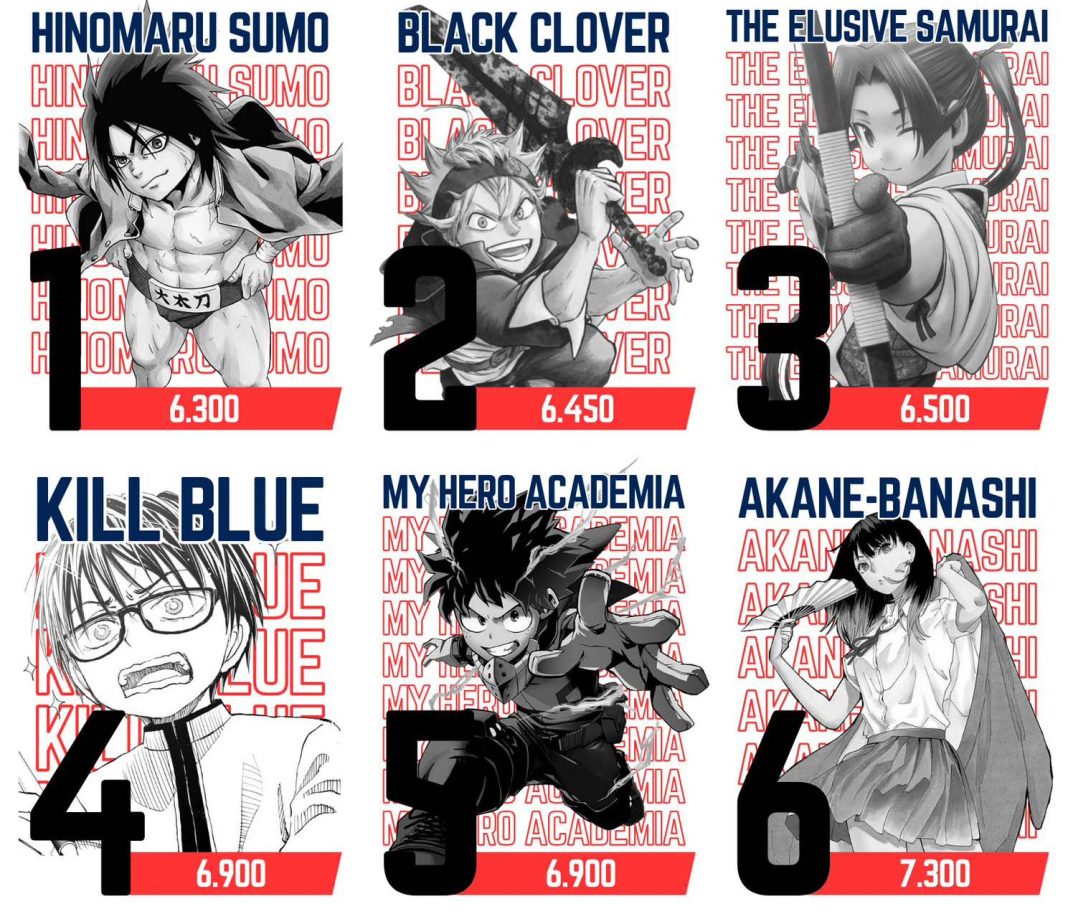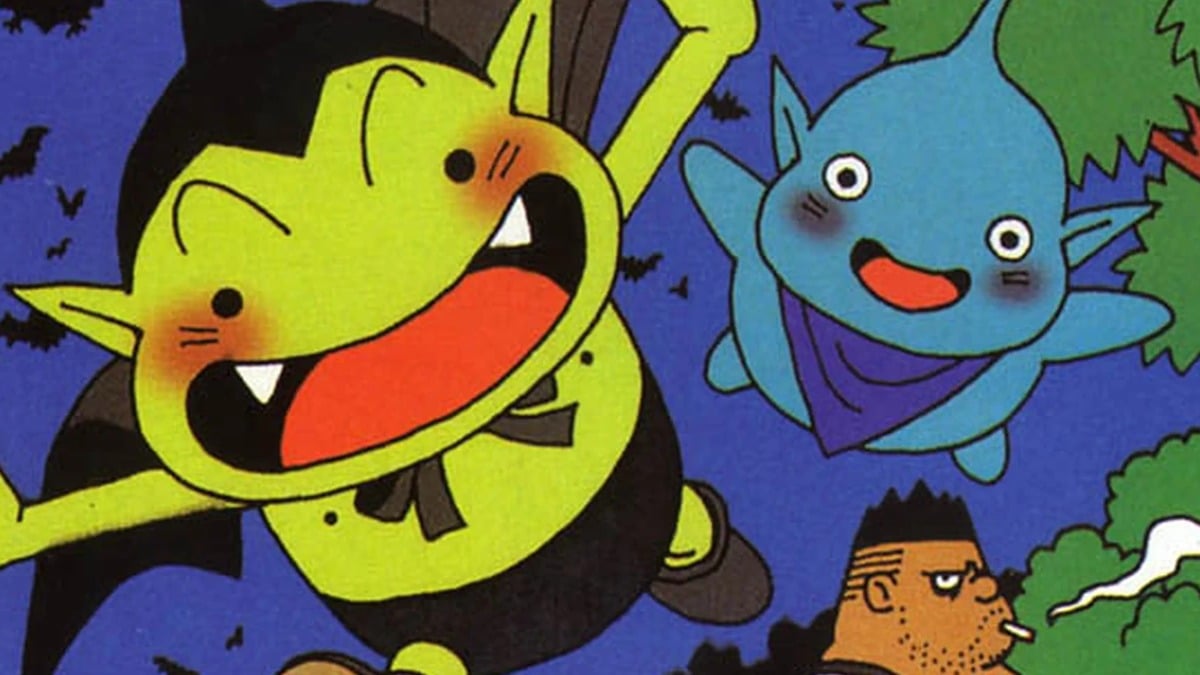Weekly Shonen Jump, Shueisha’s flagship shonen manga magazine, is where timeless classics like Dragon Ball, Naruto, and One Piece were born and raised. We’re not talking small fry here. This is the big league of manga magazines. In Japan, it is the king in the castle, with over 1.5 million weekly copies in circulation as of 2021.
That’s down significantly from its peak in the 1980s-90s, when up to 6.5 million copies would get sold weekly in bookstores and newsstands in Japan. However, when you consider that on a good week, a top selling DC or Marvel periodical comic sells about 40,000 copies nowadays, Weekly Shonen Jump is still the real deal.
When it comes to making a splash in Weekly Shonen Jump, nailing that first impression is crucial. So, I came up with this list of the Top 10 best starts in the last 10 years by checking out the average ToC rankings for their first 20 chapters. Don’t know what a ToC ranking is? Don’t worry, the nerd talk will come later. Now, the results? They’re a real eye-opener with some shocking series making it into the list! Here’s the Top 10:
TOP 10 BEST STARTS IN SHONEN JUMP (Last 10 Years) | Average ToC Ranking
After seeing the explosive reception Kill Blue got since its release, I wondered: What other series have achieved something similar in its first 20 chapters? So this graphic is the result! pic.twitter.com/tN4qebC2SV
— Nᴇᴢネズ (@mangaxrepublic) October 2, 2023
Here’s the full graphic, since the embedded Twitter/X excerpt only shows the Top 6:
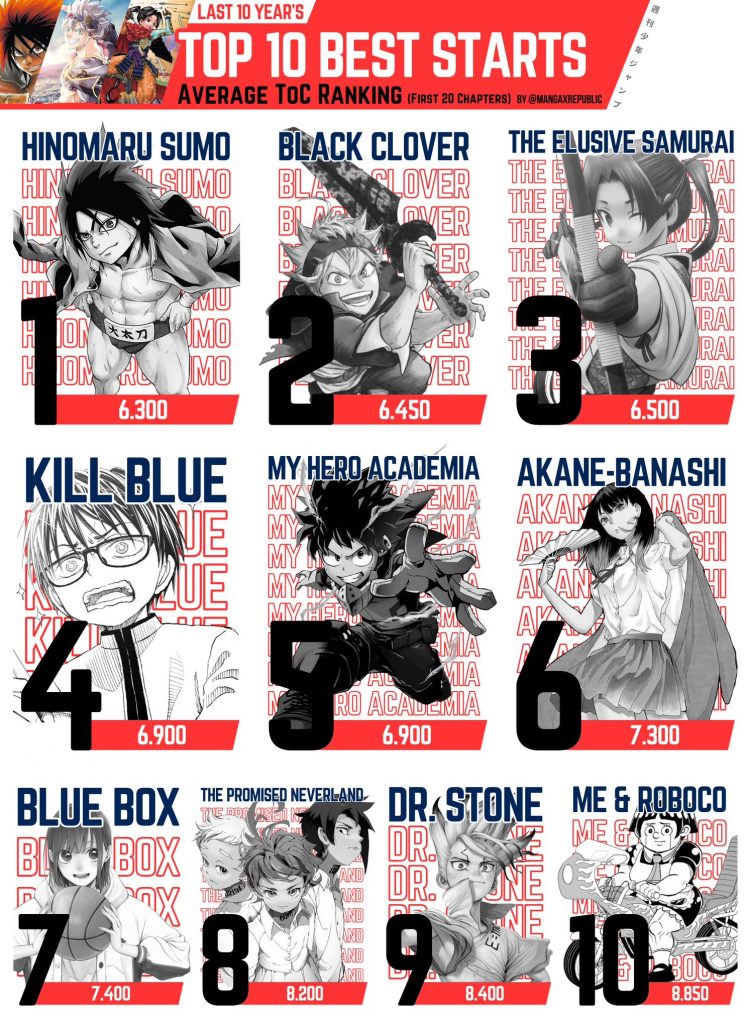
What is a ToC ranking?
Nerd talk here. It is a bit hard to explain a ToC ranking briefly, so you can choose to read the short explanation and go on to the analysis or read the longer, more complete version.
Short version: The ToC ranking is a reflection of a series’ popularity and reader reception.
Long version: ToC stands for ‘Table of Contents’ and it lists the manga series in the magazine in order. The series placements are decided by the magazine’s editors, but in Shonen Jump, readers also get to chime in usually online or by filling out and returning postcards included in the weekly print magazine. Readers vote for their Top 3 chapters each week, and the editors use these reader surveys as a reference to help them decide a series’ ranking in the coming magazine issues. It’s like a popularity showdown, where a higher rank means more love from readers.
Here’s what a typical Weekly Shonen Jump table of contents page looks like in the Japanese print edition of the magazine (courtesy of this blog post from VIZ Media that also explains a bit about the survey system):
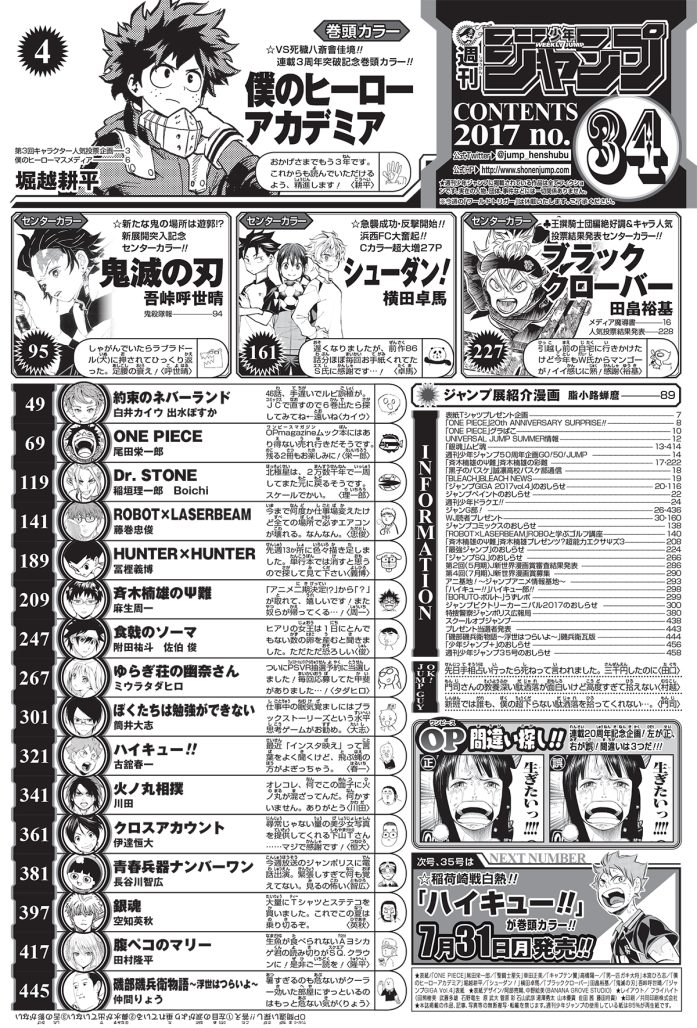
Here’s the catch: ToC rankings are not 100% reliable. ToC rankings can be a bit wonky because WSJ editors like to shake things up regularly. It is by no means an absolute or transparent indicator of a series’ popularity or reader reception.
So, why do we even bother? Well, you have to look beyond the individual ranks and see the bigger picture. If you look at the week-to-week trends, you will notice some intriguing patterns. Those trends are a closer approximation to a series’ popularity and reception among readers. And the average ToC ranking? That’s just a nifty metric that measures those popularity trends by averaging the ToC rankings within a particular time frame.
Quick reminder that this popularity-driven ToC ranking system is only noticeable in Weekly Shonen Jump, with other manga magazines choosing another approach to order their series.
With the ToC ranking explanation out of the way, let’s dive into the analysis!
The list kicks off with a real curveball. Hinomaru Sumo by Kawada takes the #1 spot with an impressive average ToC ranking of 6.300! I’ll admit, it totally slipped under my radar as it is a series that did not resonate strongly in the West. In fact, this series about a high school sumo wrestling team is the only series mentioned in the Top 10 that isn’t available to read on BOTH VIZ Media’s Shonen Jump website/app and subscription service and Shueisha’s MANGA Plus website/app – it’s a MANGA Plus only title for now.
What’s even more surprising is that, although a success, it’s not the kind of mega-hit you’d expect to top this sort of list. The series followed a pretty standard Shonen Jump success trajectory, getting a 24-episode anime adaptation in 2018 that’s currently streaming on Crunchyroll.
Black Clover and My Hero Academia, are both iconic, perennially popular series now and were instant hits when they debuted in the magazine too. Their presence on this Top 10 list shouldn’t come as a shock to anybody, since their success as part of the Weekly Shonen Jump line-up is paramount.

Next, we got Akane-banashi and Blue Box practically shoulder to shoulder in the rankings! It makes sense since, to this day, both series continue to rank closely in the magazine. The only distinguishing factor is that Blue Box received a coveted second cover and lead color page in Chapter 13. A rare and remarkable feat reserved for the crème de la crème, speaking volumes about its reception!
Akane-banashi, a story about a young woman who takes up rakugo, a form of traditional Japanese storytelling, by Yuki Suenaga and Takamasa Mosue is serialized weekly on Shonen Jump, and VIZ Media’s release of the first volume of the print edition of this series just hit stores in August 2023.
Blue Box, a high school sports/slice-of-life romance by Kouji Miura, is currently six volumes into its print edition releases from VIZ Media, with volume 7 to follow in November 2023.
The last three positions are taken by The Promised Neverland and Dr. STONE, two heavyweight fantasy-action series, followed by gag manga Me & Roboco. These three manga series have held down the fort for their specific niches in the magazine, and each have received anime adaptations. The first two became extremely popular, especially in the West, while Me & Roboco has successfully crowdfunded its “Roboco Infinity Train” advertising campaign in the Yamanote Line and is set to receive a movie in Winter 2024. The Me and Roboco anime series, about a 10-year-old boy and his misadventures thanks to his bizarrely strong robot maid debuted in December 2022 and is currently streaming on Crunchyroll.
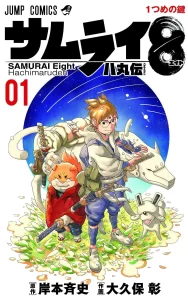
But there’s more to talk beyond the Top 10. For example, take Samurai 8: The Tale of Hachimaru, a sci-fi samurai action series by Naruto creator Masashi Kishimoto and Akira Okubo, and The Ichinose Family’s Deadly Sins by Taizan5 (creator of the surprise hit in Japan and upcoming Viz Signature manga release, Takopi’s Original Sin). Both of these series narrowly missed this Top 10 list, ranking 11th and 12th, with average ToC ranks of 8.850 and 9.150, respectively.
Samurai 8: The Tale of Hachimaru started with promise but ended up becoming one of the magazine’s most notorious examples of failure. Considering the mastermind behind the series, expectations couldn’t be any higher, not only from readers but also from publishers. Shueisha, the Japanese powerhouse behind Shonen Jump, released the first two volumes simultaneously, something quite rare nowadays. Within six months of its debut, international print releases were swiftly announced in North America, Spain, Italy, France, and Germany.
The electrifying excitement quickly buzzed off, with the first two volumes struggling to sell over 20 thousand copies in their first week, combined. These numbers would be comfortable enough to rank among the monthly Top 10 best-selling comics in the U.S., but in Japan, these numbers are under par. In the same week, Chainsaw Man Vol. 2 sold nearly 40 thousand copies and SPY×FAMILY Vol. 2 by rookie mangaka Tatsuya Endo soared past 100 thousand units sold. Samurai 8’s sales were a big disappointment, especially by Shonen Jump’s standards.
Adding salt to the wound, Samurai 8‘s ToC rankings quickly plummeted, spending most of its run at the bottom of the magazine. It became clear that the series’ impressive start might have been fueled by the editors’ promotion that over time lost steam, rather than by its own merits. Of course, this last bit is speculation on my part, but it makes sense after the series wrapped up after just 43 chapters collected into 5 volumes. What appeared to be another hit quickly became a huge letdown.
The Ichinose Family’s Deadly Sins is not faring well either. This family drama series about a whole family suffering from amnesia after a car accident has now become the second worst-performing series ToC-wise in the current line-up in the magazine. Another highly anticipated series by a hit author that is not living up to expectations, currently with the upsetting overall average ToC ranking of 12.628.

Nue’s Exorcist, a new series by rookie Kota Kawae that debuted in May 2023 alongside Kill Blue, was initially in the Top 10 by chapter 19. But by the time the 20th chapter of this exorcism action series, centered around a high school student and the incidents with a spirit who loves video games, was published, its ranking slipped to 14th place. It still boasted an impressive average ToC ranking of 9.300, showcasing another promising start that has the potential to become another mainstay series in the magazine.
Japanese readers have really taken a liking to this series. In just 20 chapters, Nue’s Exorcist has received a total of 5 color pages, which is absolutely insane! Akane-banashi accomplished the same feat too. It has also launched an official Twitter account, a testament to its rising popularity. Although a sprinkle of skepticism is always needed when it comes to predicting success in Shonen Jump, all signs are pointing upward for Nue’s Exorcist.
Furthermore, there are many prosperous series that didn’t quite crack this Top 10 list. Demon Slayer (9.850) and Jujutsu Kaisen (10.200), arguably the most successful Jump series of recent times, also missed the cut. Just because they’re not on this list doesn’t mean they weren’t well-received. In fact, Demon Slayer received a rare second color page in Chapter 7 as a testament to its good reception among readers, as revealed by the series editor Tatsuhiko Katayama.
What can we learn from this? Basically, that this ToC ranking list is not a 100% reliable measure of reader popularity and a strong placement here doesn’t guarantee long-term success. The list only accounts for the first 20 chapters, a number I picked because it offers a reasonable time frame to demonstrate a series’ reception, but also because it is a pretty number. But if we tweaked that number to 19 or 21 chapters, that could do the job just as well, the rankings would vary considerably and the list would look completely different.
So, don’t treat this as the definitive list of the best Shonen Jump new series starts. Think of it as a handy point of reference in the ever-changing world of Weekly Shonen Jump rankings.
All in all, the list is quite diverse and packed with surprises, featuring some standout titles. It offers a fascinating glimpse into the ups and downs, the ins and outs of the dynamic landscape of Weekly Shonen Jump over the last decade. This list should serve as a friendly reminder that a series with good ToC rankings has the prospect of becoming something big.
While the influence Japanese readers hold over the future of the series in the magazine is crystal clear, it can be downright frustrating for overseas fans to see series they love, such as The Hunters Guild: Red Hood or Ayashimon, end prematurely due to poor reception in Japan. However, the Japanese readers’ monopoly over the power to shape the magazine might come to an end. It seems Shueisha wants more information for their ToC rankings: At NYCC they are asking their booth visitors to vote for their favorite newcomer series in MANGA Plus. This move marks a rare instance of Shueisha directly soliciting feedback from their overseas fans. So who knows? Things might turn up for the better for all the Weekly Shonen Jump fans outside Japan!
You can read the latest manga chapters in English from Weekly Shonen Jump and other Jump magazines from VIZ Media’s Shonen Jump website/apps or by visiting Shueisha’s Manga Plus website/apps.


